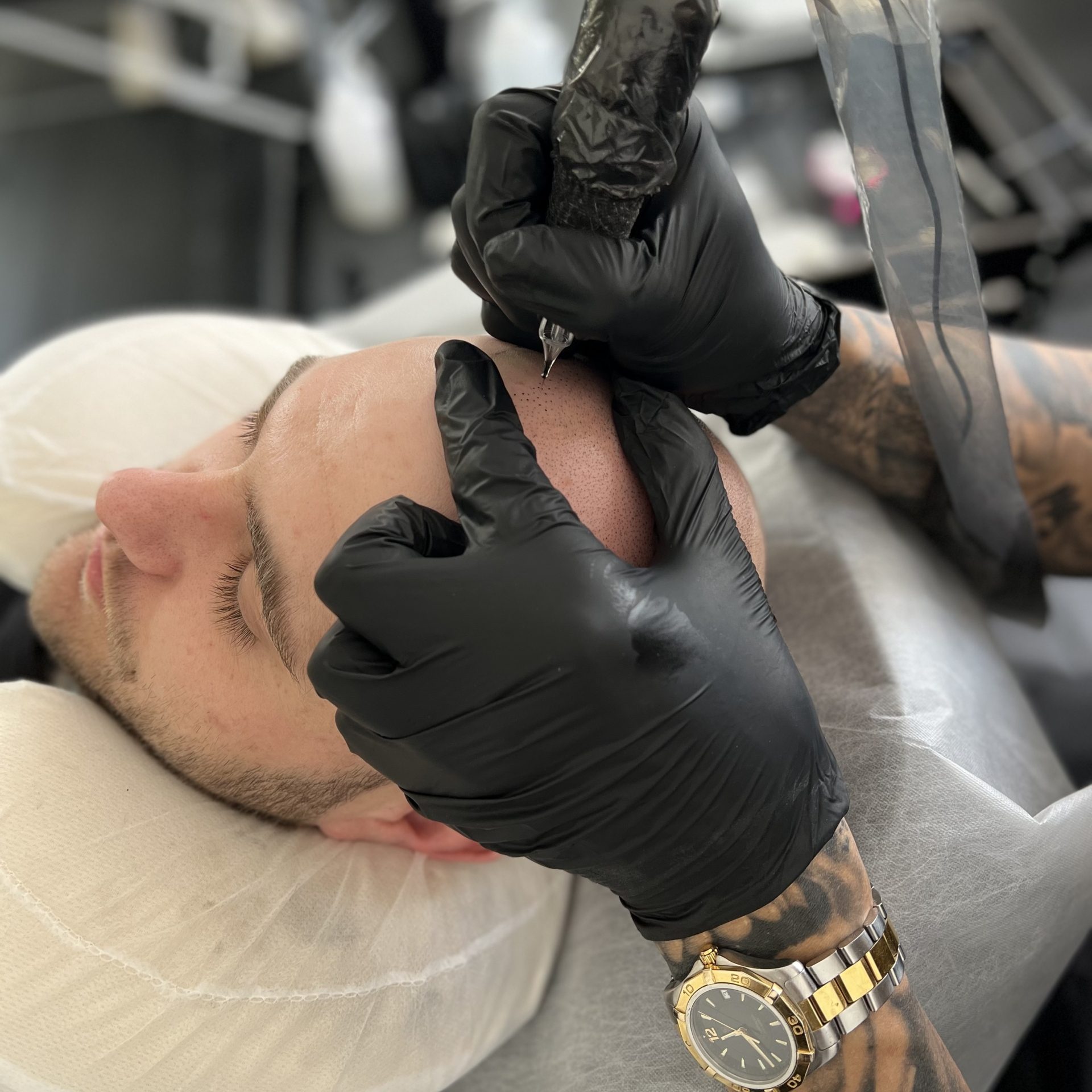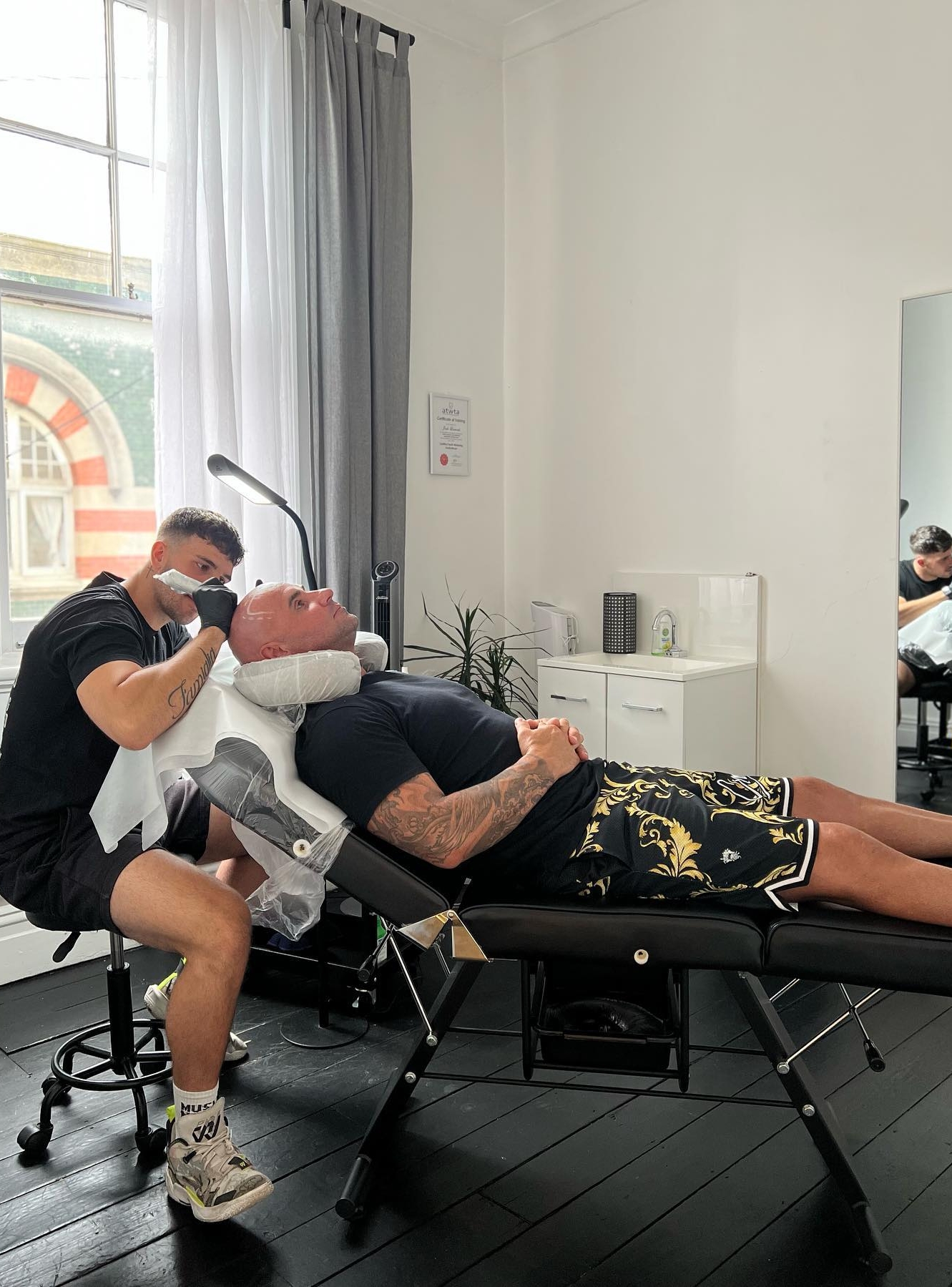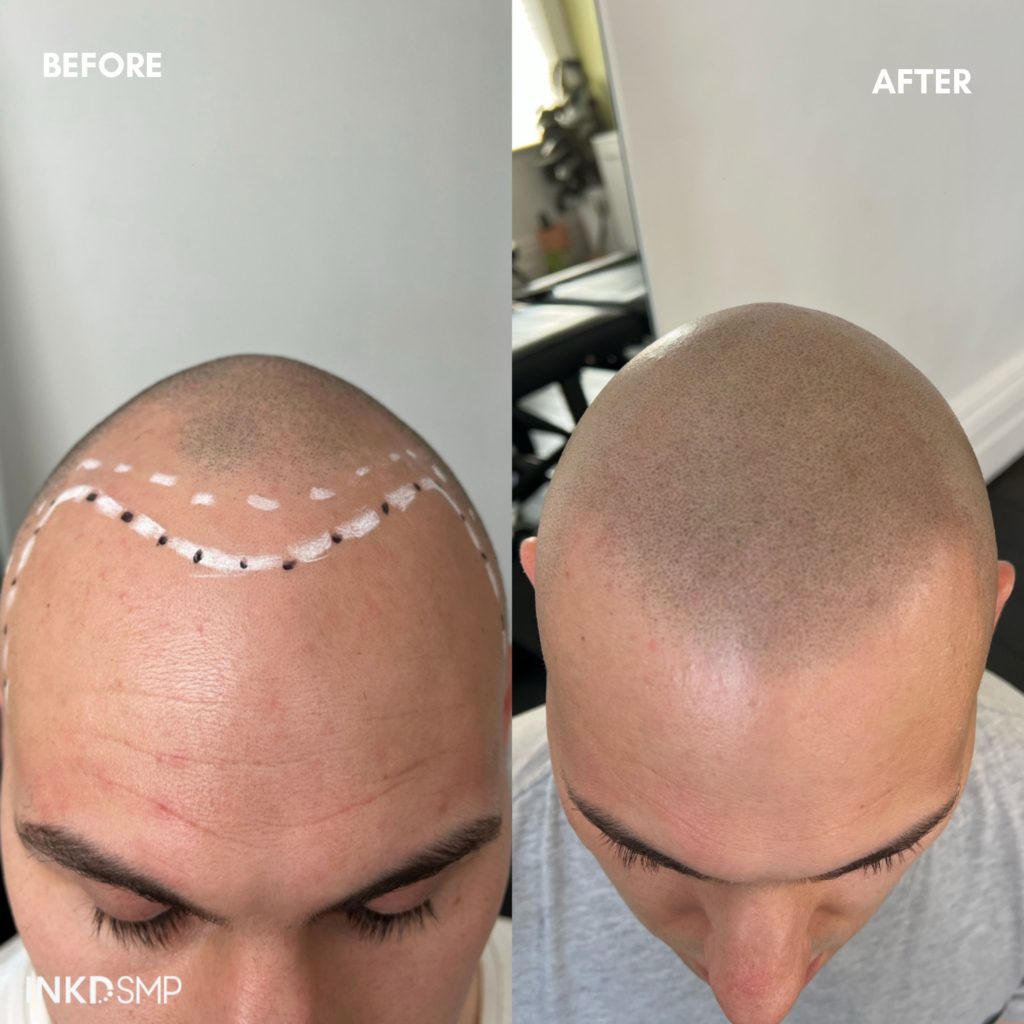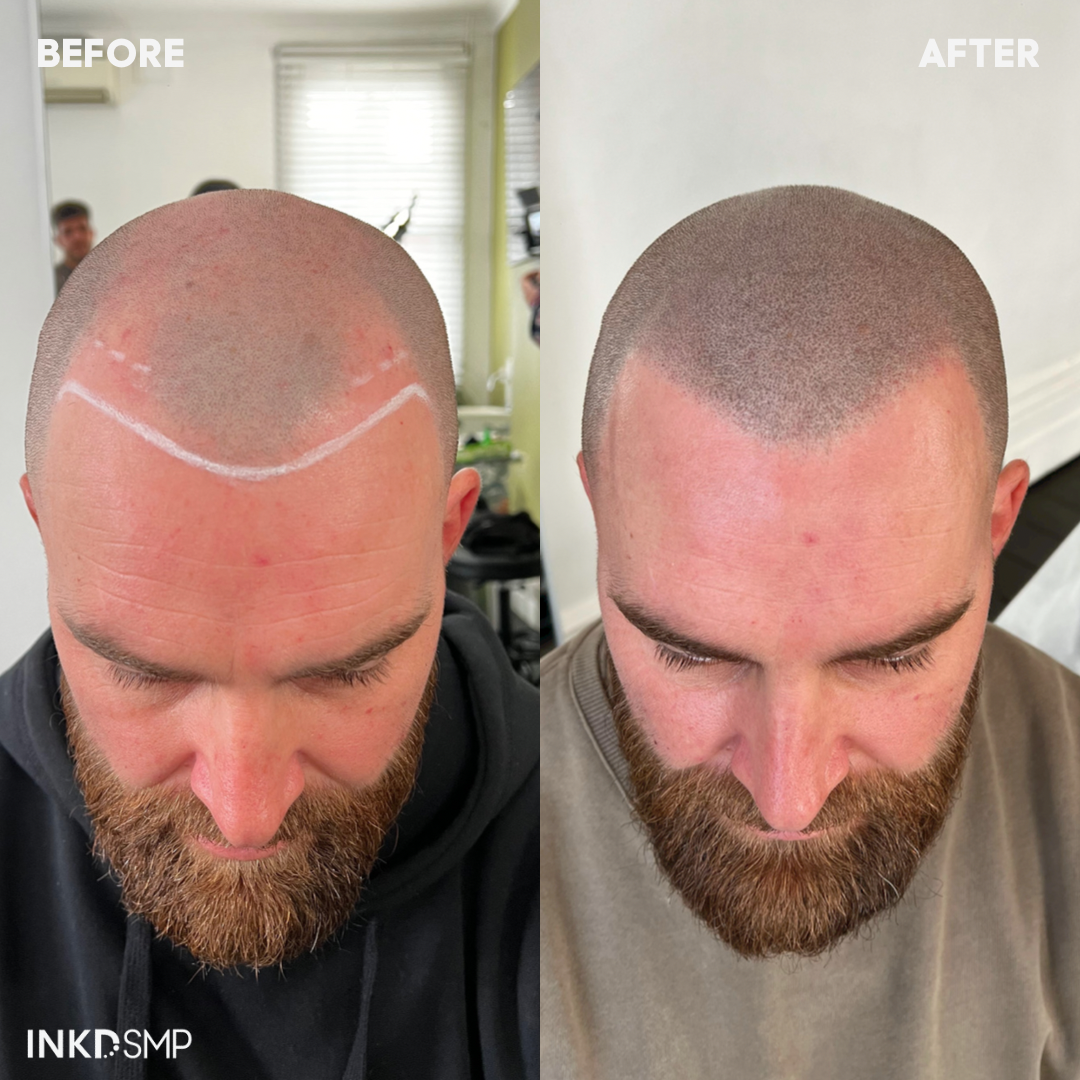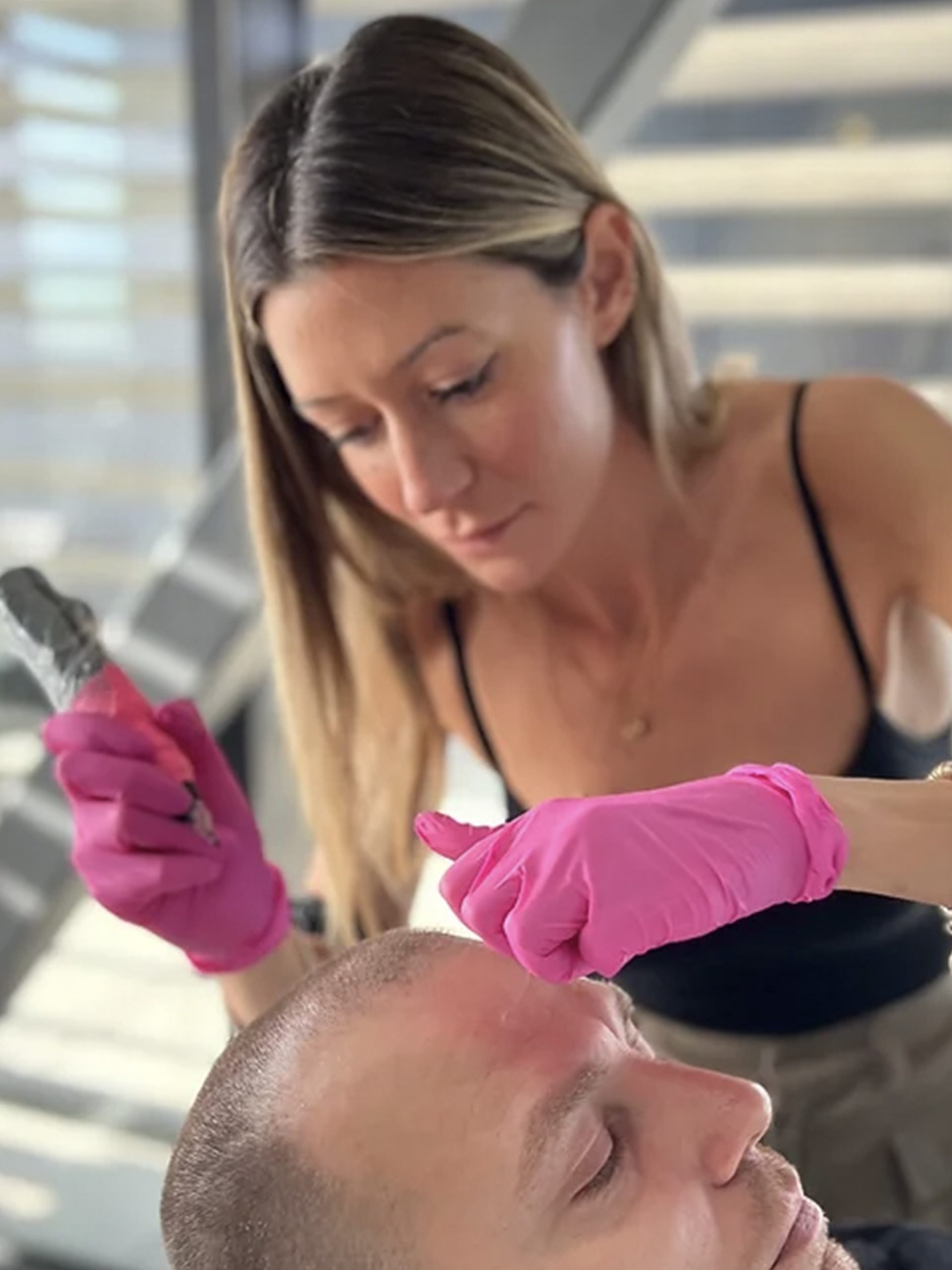The Ultimate Guide: SMP vs Hair Transplant for Hair Loss Solutions
If you are one of the many suffering from hair thinning or loss, you know just how big of a blow it can be to your confidence. In fact, around 50% of men will be affected by male pattern baldness, while around 40% of women will see some signs of hair thinning by the time they are 50 years of age.
It’s not all doom and gloom though as there are now several new methods available for hair restoration! The two hair restoration treatments that are sweeping the globe at the moment are scalp micropigmentation (SMP) and hair transplants. So, you’ve got options, yay! But this means you’ll have to figure out which one is best for you.
A hair transplant involves a surgical procedure where healthy hair follicles are removed from an area of your scalp and inserted into the affected area. While hair transplant surgery is known to be more invasive, the results are usually permanent. This type of surgery won’t necessarily work for everyone though, as you need existing hair follicles for the hair transplantation to be successful.
With 70% of hair transplant patients reporting a satisfaction rate of “high” to “very high” post-procedure, it is understandable that many turn to hair transplants first. But is it worthy of all the attention it is receiving when it isn’t a viable solution for every individual? On the flip side, SMP is a low-maintenance, less invasive and highly versatile option available to everyone and provides hope to those who have complete baldness and have been told they’ll never be able to grow it back on their own.
You must understand the ins and outs of both SMP and hair transplants as your individual situation will determine which method you will have the most success with. This is all well and good, but what is actually involved in the hair transplant and SMP process? Well, you’ve come to the right place as this article takes a deep dive into both these commonly used methods to treat this issue.

Understanding Hair Loss
Men and women alike can experience hair loss and there are many causes. The root cause of this will determine whether it falls out gradually or quickly, thins, can regrow naturally, requires regrowth treatment or needs immediate attention to prevent permanent loss of hair.
Some of the main causes of thinning and loss include:
- Hereditary – Regrowth is possible with certain treatments, but without treatment, you’ll continue to lose your hair.
- Age – If caught early, regrowth may be possible.
- Alopecia areata – Regrowth is possible if your hair doesn’t grow back on its own.
- Stress – If the source of stress stops, your hair will likely return to normal fullness.
- Hormonal imbalance – Hair regrowth treatments may be able to help.
If this is something you are experiencing, you must address the issue as quickly as possible. The sooner you start treatment (if needed) the more likely it will be successful. Therefore you should understand what is causing your loss and if treatment is a viable option, start treatment right away.
What is Scalp Micropigmentation (SMP)?
If you’re looking for different treatment methods for your hair thinning or loss, one of the options to be considered is scalp micropigmentation. SMP is a cosmetic treatment that helps to create the appearance of hair. This treatment uses a fine needle to apply small dots to your scalp.
SMP treatment can help in a couple of different areas:
- Restore thinning hairlines or create a new hairline (provides a “buzz cut” look).
- Thicken the look and help disguise thinning.
- Conceal and camouflage scars on the scalp.
- Create the appearance of fuller and thicker hair for females.
How Does SMP Work?
The SMP process works by tattooing a pattern of dots onto your scalp, creating the appearance of hair. While the process resembles getting a tattoo, it is different as SMP uses an ultra-fine needle, injecting pigments into the dermis layer of your skin. SMP treatment doesn’t inject ink as deep as a normal tattoo.
SMP can provide the look of a fuller head of hair and allows for a more natural look. Whether you want the shaved look or provide depth of thinning hair, SMP is an option that can help you achieve this. This scalp micro pigmentation treatment may help those suffering from:
- Hereditary balding
- Scalp scars or birthmarks
- Alopecia
- The loss of hair from cancer treatments
SMP Procedure and Benefits
To limit further loss of hair, many are considering SMP. But before you jump in with both feet, it’s a good idea to understand the main steps involved before, during and after the hair restoration treatment.
Before SMP Treatment
Before your initial treatment, it’s important you set up a free consultation, so you can understand the process, including what the results will look like, the costs associated with the treatment and more. Now would also be the time to disclose allergies or intolerances. A patch test might be done to ensure no reaction will occur.
In your initial consultation, it is also important to define your natural hairline and choose the correct pigment and technique to ensure the best results possible. Once this is all nailed down, you can book your date for your SMP session.
Before your session, you’ll likely receive a set of instructions to follow, like:
- Reduce caffeine intake
- Avoid sun exposition
- No blood thinners for at least ten days before treatment
- No smoking for at least two hours before treatment
During SMP Treatment
There will usually be three to four treatment sessions that take place over six to eight weeks. Throughout each session, micro-needles will be used to apply pigment to your scalp, gradually building up the appearance of hair follicles.
Minimal pain is usually experienced and you can get on with your day straight after each session. You will also likely experience minor redness, but this will usually subside within a day. The amount of sessions required will be determined by the look you are trying to achieve.
After SMP Treatment
To allow the healing process to be effective, there are a few steps you are required to follow after your treatment. For the three days following the treatment, you should avoid water on the scalp and avoid excessive sweating, direct sunlight and products. Following this advice during the healing period will help provide optimal results.
SMP is a semi-permanent solution and may require occasional touch-up sessions to maintain its appearance over the years. The frequency of these sessions will depend on a couple of factors, including; skin type, lifestyle and desired hair density.
SMP Pros and Cons
SMP could be an alternative option for individuals who don’t want to go down the path of hair transplant surgery or those who didn’t achieve the desired results through this method. If you think SMP might be the option for you, there are some pros and cons you should be aware of.
Some of the main pros of SMP can be found below:
- Semi-permanent solution – SMP provides long-lasting results and you could achieve your desired final density for years with only the occasion retouch session needed to maintain your look.
- Natural appearance – SMP really does look like you have new hair as the treatment mimics the natural growth pattern. The shaved head look, in particular, is virtually undetectable.
- Boost confidence – SMP treatment can help you get your confidence back, no more hiding behind a hat! Transforming your appearance and getting the look of real hair can work wonders improving your confidence.
- Low maintenance – After your sessions are completed, it’s essentially “set and forget”. You’ll have a more natural appearance and won’t have to spend hours upon hours in front of a mirror trying to make something work.
- Highly suitable – SMP is a versatile option and is effective no matter your age, gender or colour. Even if you’ve experienced extensive loss, SMP is a viable option.
Some of the few cons of SMP can be found below:
- Won’t grow back – As SMP is a medical hair tattoo treatment, it means your hair won’t grow back naturally. It limits your hairstyle choices but if hair growth is out of the picture completely, you would already know this!
- Risk of botched treatment – There is always the risk of the SMP provider cutting corners or simply being inexperienced. This is why it is always recommended to do your research and choose a highly-trained and experienced provider.
What is a Hair Transplant?
Now that you know more about scalp micropigmentation, let’s go into another common method used to combat hair thinning. So, how does a hair transplant work? Well, it involves a surgical procedure that takes hair follicles from one part of your scalp and places them in another part, which is impacted by thinning hair or loss. There are several different techniques for a hair transplant.
Transplants are commonly used by those impacted by male pattern baldness. However, it is important to note that hair transplantation is not a cure for this as the transplanted hair covers the bald spots and hair loss may still be experienced which could result in further hair transplantation. This is why many choose to combine treatment solutions, to ensure they get the desired look.
Different Types of Hair Transplant Procedures
For transplant procedures, there are two main types you can choose from:
- Follicular Unit Extraction (FUE) – The FUE hair transplant procedure is a minimally invasive technique used to remove hair grafts from the back of your scalp as individual follicles and then place them in the small holes created by your thinning or no hair.
- Follicular Unit Transplantation (FUT) – The FUT hair transplant procedure is known to be more invasive compared to that of the FUE procedure and involves removing a strip of your scalp from the back and then dissecting it into individual follicles to transplant back into the affected area.
Hair Transplants vs. SMP – Key Differences
When comparing hair transplants and scalp micropigmentation, there are obviously a few key differences. Understanding these differences will allow you to decide which procedure is right for you. The main areas these two techniques differ that you should be aware of include:
- Time – The length of a transplant is around eight to 10 hours, but the recovery time is usually longer compared to SMP and the desired results will usually take six to 12 months. For SMP, the treatment is completed over three to four sessions across six to eight weeks. The healing process only takes a handful of days and after your last session, you should have your desired result.
- Level of pain – Usually, a hair transplant results in less pain than compared to SMP as you would likely receive anaesthetic. However, this is only for the actual procedure and afterwards, the pain will usually last for three to four days. For scalp micropigmentation, the level of pain will vary from person to person. While it process loosely resembles that of a tattoo, it is known to not be as painful.
- Effectiveness – Transplants are invasive, but it is a long-term solution. Incisions are made and can leave scars. On top of this, post-surgery treatment can be extensive and the transplanted hair might not look as natural as you had hoped. Scalp micropigmentation is very effective and provides a semi-permanent solution, with none or minimal scarring that is easy to maintain.
- Cost – When it comes to hair restoration procedures, cost is a major consideration. While it is difficult to nail down the exact price of a transplant, scalp micropigmentation will almost always be the more cost-effective option, as the nature of the procedure is much simpler.
Combining SMP and Hair Transplant for Enhanced Results
With scalp micropigmentation and hair transplants, it doesn’t have to be one or the other! These two procedures can be combined to enhance results and give you that natural hair look you’ve been craving. Previous hair transplant patients may experience scarring from this procedure and scalp micropigmentation can assist in scar camouflage and improved hairline definition.
Combining scalp micropigmentation with a transplant has several benefits, including:
- Enhanced coverage – While a hair transplant may not get the job completely done with your healthy follicles, scalp micropigmentation can finish it off, providing you with better coverage and thickness.
- Improved hairline – The desired coverage and density might not be achieved with a hair transplant, so scalp micropigmentation and define your hairline further, giving you the desired effect.
- Scar tissue camouflage – A FUT or FUE hair transplant may result in some scarring. If there is scarring from previous surgeries, scalp micropigmentation can work to successfully cover up the scars and give you a more natural look.
- Addressing diffused thinning – Unfortunately, if you are experiencing extensive hair loss, you likely won’t have enough donor hair for a transplant. If there aren’t normal donor densities in the donor area, scalp micropigmentation can help fill in the gaps.
Choosing the Right Procedure for Your Hair Loss
To get the optimum head of hair back, you must be the right candidate for the specific procedure. Remember, if a hair transplant won’t give you the final result you’re looking for, you can combine it with SMP, with the procedures working together to give you the look you want.
For a hair transplant, the factors to consider to understand if you’re an ideal candidate include:
- Age – The ideal range for a transplant is usually between 25 to 65.
- Existing hair growth – There should already be growth in the donor area. If the hair is heavily donor depleted, you might not be a good candidate.
- Loss pattern – This type of surgery is most successful in candidates whose hair is thinning or lost only at the top and front of the head.
- General health – The ideal candidate should be in good general health and not have a compromised immune system. If you’re a smoker, this could limit the rate of success.
- Family history – Genetic factors come into play here and if you have a strong history of hair loss in your family, transplanted hairs might not grow as desired.
The ideal candidate for SMP is much broader compared to that of a transplant. You’d be an ideal candidate for SMP if you:
- Are experiencing male (or female) pattern baldness
- Have scars or a skin condition on your scalp
- Are experiencing hair thinning or loss
- Want a non-surgical option
- Are looking for a low-maintenance solution
- Are experiencing a receding hairline
Hair Loss Solutions – SMP, Transplant or Both?
So, which hair loss solution is for you? Well, it really depends on your individual situation and it may be the case that you aren’t an ideal candidate for a transplant (if you don’t have enough existing hair for the donor site, for example), which means the decision will pretty much be made for you. It also depends on your individual goals.
Remember, there are different types of procedures, like a FUE hair transplant, so you’ll have to consider that as well. SMP, on the other hand, isn’t as invasive, which is a major consideration when deciding which solution is best for you. You also have somewhat more control over the look you want with SMP. For example, if you’re looking for a shaven head look, SMP is probably the best option.
SMP can also work in tandem with a transplant, for example, if there are significantly scarred donor areas, SMP can help to cover that part of your skin up and give you the look you’re going for. It doesn’t matter if you have very short hair or no hair at all, SMP can help.
Conclusion – Finding the Best Solution for Your Hair Loss
If you are experiencing hair thinning or loss, you are certainly not alone. There are many treatments available so you can get your confidence back and start living your best life! Choosing the right treatment for you shouldn’t be a difficult task, but you must have all the information so you can make a decision that leads to the best results possible.
Hair transplants and SMP are both viable and popular solutions to give you that full head of hair look you’re striving for. Hair transplants are slightly more invasive, taking longer to see results and and the end of the day, might be successful or provide you with the right look.
For hair growth, transplants are fairly successful if you are the right candidate. SMP will work for anyone, no matter your skin tone or the state of your hair. It is considered to be a semi-permanent and low-maintenance option.
SMP or Hair Transplant FAQs
You’ve got questions, we’ve got answers! We’ve gone through and found some of the most common questions people have about these two different hair restoration procedures. Check out all the FAQs below.
What is scalp micropigmentation (SMP)?
SMP is known as a cosmetic treatment option that uses a fine needle and applies small dots to the skin of your head. Anyone from a light to a dark skin tone can undergo this treatment option.
What is a hair transplant?
This procedure involves taking healthy follicles from one part of your head and putting it in another part, that has been impacted by thinning or loss.
How do SMP and a transplant differ?
The main difference is that SMP is a non-invasive procedure and it is available to anyone who has experienced hair thinning or loss. While it doesn’t prevent further hair loss, even if you’ve had laser removal, SMP works as it is a cosmetic procedure.
Which treatment is more effective for hair loss?
Both treatments are effective in different ways. If the possibility of ever regrowing your hair has gone, SMP presents as a viable option, especially if you want to get the shaved hair look.
What are the pros and cons of SMP?
For SMP, the main pros include; a semi-permanent option, natural appearance, boosts confidence, low maintenance and highly-versatile. The cons of SMP include; your hair won’t naturally grow back and the risk of a botched job.
What are the pros and cons of a transplant?
For a transplant, the main pros include; boosting confidence, naturally growing back hair, being easy to maintain and being a permanent option. The cons of a transplant include; more invasive, cost and surgery is required.
How long do the results of SMP last?
SMP is a semi-permanent option and you’ll only need a handful of re-touch sessions in the future to ensure it is looking as good as you desire.
How long do the results of a transplant last?
The results of a transplant are expected to be permanent. In saying that, things don’t always necessarily go to plan and you could be left with visible scars from the procedure.
What is the cost difference between SMP and a transplant?
While the cost is likely to vary depending on your individual situation, it is widely expected that the SMP procedure is more cost-effective than compared to a transplant.
What is the recovery time for SMP and a transplant?
The recovery time for SMP is usually only a handful of days and for a transplant, it is about a week. You’ll have post-procedure instructions for both to follow, this will ensure the best result possible.
Are there any risks or side effects associated with SMP and a transplant?
There are minimal risks associated with both procedures. There are more risks associated with a transplant due to the invasive nature of the procedure. Make sure that you follow post-procedure instructions carefully to limit the level of risk or side effects.
How do I choose between SMP and a transplant?
You should first see if you are an ideal candidate for both procedures as this could limit your options. Understand what is involved with each procedure to see which one is most suitable for your individual situation.

